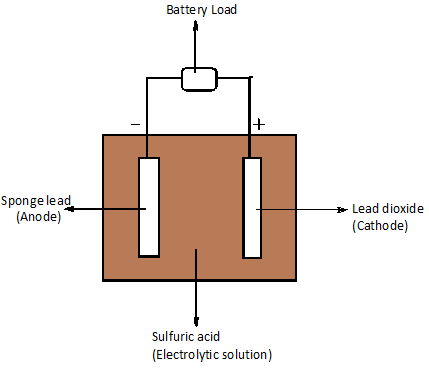
In lead acid battery electrolyte used is:
A.Sulphuric acid
B.Aqueous solution of
C.Nitric acid
D.Aqueous solution of
Answer
478.5k+ views
1 likes
Hint: As we know that the lead acid battery will have two electrodes and an electrolytic solution. The electrodes present in lead acid batteries are lead and lead dioxide.
Complete step by step answer:Lead acid batteries have a small energy-to-volume ratio and a very low energy-to-weight ratio; its ability to supply high contents reveals that the cell has a large power-to-weight ratio. Lead-acid batteries are categorized by secondary batteries. The chemical reactions, which occur in secondary cells, are reversible.
The commercial forms of lead acid batteries consist of six (or) twelve lead storage cells linked together.
Lead storage batteries are otherwise called lead-acid batteries. It is a secondary voltaic cell. The anode is made up of spongy porous lead and the cathode is made up of lead dioxide. The electrolyte used is sulfuric acid.
The active materials present on the plate of the battery (electrodes) are lead and lead dioxide. They react with sulfuric acid (electrolyte) to form lead sulfate. The formed lead sulfate is in amorphous state, finely divided and when the battery recharges it again forms lead, lead dioxide and sulfuric acid.

Lead acid batteries are used in large backup power supplies for telephone and compound centers, grid energy storage and as emergency lighting and to power sump pumps in power failure.
Therefore, the option (A) is correct.
Note:As we that lead storage batteries are cost efficient. They have low internal impedance and are tolerant to overcharging. They are also heavy and bulky with a cycle life of 300 to 500 cycles. There are varieties of lead acid batteries such as lead calcium battery, lead antimony battery etc.
Complete step by step answer:Lead acid batteries have a small energy-to-volume ratio and a very low energy-to-weight ratio; its ability to supply high contents reveals that the cell has a large power-to-weight ratio. Lead-acid batteries are categorized by secondary batteries. The chemical reactions, which occur in secondary cells, are reversible.
The commercial forms of lead acid batteries consist of six (or) twelve lead storage cells linked together.
Lead storage batteries are otherwise called lead-acid batteries. It is a secondary voltaic cell. The anode is made up of spongy porous lead and the cathode is made up of lead dioxide. The electrolyte used is sulfuric acid.
The active materials present on the plate of the battery (electrodes) are lead and lead dioxide. They react with sulfuric acid (electrolyte) to form lead sulfate. The formed lead sulfate is in amorphous state, finely divided and when the battery recharges it again forms lead, lead dioxide and sulfuric acid.

Lead acid batteries are used in large backup power supplies for telephone and compound centers, grid energy storage and as emergency lighting and to power sump pumps in power failure.
Therefore, the option (A) is correct.
Note:As we that lead storage batteries are cost efficient. They have low internal impedance and are tolerant to overcharging. They are also heavy and bulky with a cycle life of 300 to 500 cycles. There are varieties of lead acid batteries such as lead calcium battery, lead antimony battery etc.
Recently Updated Pages
Express the following as a fraction and simplify a class 7 maths CBSE

The length and width of a rectangle are in ratio of class 7 maths CBSE

The ratio of the income to the expenditure of a family class 7 maths CBSE

How do you write 025 million in scientific notatio class 7 maths CBSE

How do you convert 295 meters per second to kilometers class 7 maths CBSE

Write the following in Roman numerals 25819 class 7 maths CBSE

Trending doubts
What are Quantum numbers Explain the quantum number class 11 chemistry CBSE

Write the differences between monocot plants and dicot class 11 biology CBSE

In northern hemisphere 21st March is called as A Vernal class 11 social science CBSE

1 Quintal is equal to a 110 kg b 10 kg c 100kg d 1000 class 11 physics CBSE

List out the uses of ethanoic acid class 11 chemistry CBSE

Number of oneone functions from A to B where nA 4 and class 11 maths CBSE




